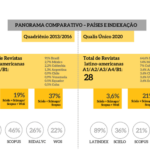
Image: makyzz / Freepik.
By Jan Velterop
On an earlier post1, I have made the case for separating the communication of research results and their assessment. But what are the potential consequences and opportunities for journals, and for those judging the quality or significance of journal articles?
Up until now, the functions of communication and assessment were combined. A journal did both the communication, by publishing, and the assessment, via peer review (the latter often anonymous, since it entails a recommendation to accept or reject for publication, in most cases). The process of peer review before publication necessarily introduces a delay in the communication and sharing of research results via journals. And anonymous peer review introduces the need for unquestioning trust in the peer review process and the competence of peer reviewers.
If articles are first published via so-called “preprint” platforms, and subsequently submitted to a journal for assessment, a new situation arises. There are a number of options for journals:
- They could just accept preprints as an inevitable trend, and live with it;
- They could try to thwart the development towards preprints becoming a social norm in science;
- They could see it as an opportunity.
The first option is one that is already taken by many journals, but it remains a passive one. As for the second option, history shows that trying to halt such developments may succeed for a short while, but ultimately backfire. As for the third option, this presents an opportunity for journals. The role of a journal as a primary channel for communication of research results disappears, but their role as assessors remains, and may well be enhanced. Their role could be enhanced, for instance, by reviewing and assessing articles published in other journals, and openly publishing its own reviews of those articles, with named reviewers. This is especially interesting if the journal in which the article is first published doesn’t make their peer review reports public. By providing subsequent open peer reviews about relevant articles published elsewhere, a journal could become a strong community builder in a given field.
As for research councils, funders, tenure committees, etcetera, such a wider assessment of individual articles would help them to get away from the questionable (but simple and convenient) habit of relying too much on journal-related metrics, such as impact factors. If they truly want to improve their assessment and selection procedures, they should support journals who choose the third option and take an active role in developing a more robust system of quality assessment than the current pre-publication peer review system provides.
Does all this make practical sense? That is the topic of discussion for the SciELO 20 Years conference in September 2018.
Note
1. VELTEROP, J. Communication and peer review should be universally separated [online]. SciELO in Perspective, 2018 [viewed 19 July 2018]. Available from: https://blog.scielo.org/en/2018/05/25/communication-and-peer-review-should-be-universally-separated/
Reference
VELTEROP, J. Communication and peer review should be universally separated [online]. SciELO in Perspective, 2018 [viewed 19 July 2018]. Available from: https://blog.scielo.org/en/2018/05/25/communication-and-peer-review-should-be-universally-separated/
About Jan Velterop
 Jan Velterop (1949), marine geophysicist who became a science publisher in the mid-1970s. He started his publishing career at Elsevier in Amsterdam. in 1990 he became director of a Dutch newspaper, but returned to international science publishing in 1993 at Academic Press in London, where he developed the first country-wide deal that gave electronic access to all AP journals to all institutes of higher education in the United Kingdom (later known as the BigDeal). He next joined Nature as director, but moved quickly on to help get BioMed Central off the ground. He participated in the Budapest Open Access Initiative. In 2005 he joined Springer, based in the UK as Director of Open Access. In 2008 he left to help further develop semantic approaches to accelerate scientific discovery. He is an active advocate of BOAI-compliant open access and of the use of microattribution, the hallmark of so-called “nanopublications”. He published several articles on both topics.
Jan Velterop (1949), marine geophysicist who became a science publisher in the mid-1970s. He started his publishing career at Elsevier in Amsterdam. in 1990 he became director of a Dutch newspaper, but returned to international science publishing in 1993 at Academic Press in London, where he developed the first country-wide deal that gave electronic access to all AP journals to all institutes of higher education in the United Kingdom (later known as the BigDeal). He next joined Nature as director, but moved quickly on to help get BioMed Central off the ground. He participated in the Budapest Open Access Initiative. In 2005 he joined Springer, based in the UK as Director of Open Access. In 2008 he left to help further develop semantic approaches to accelerate scientific discovery. He is an active advocate of BOAI-compliant open access and of the use of microattribution, the hallmark of so-called “nanopublications”. He published several articles on both topics.
Como citar este post [ISO 690/2010]:

















Read the comment in spanish, by Javier Santovenia Diaz:
https://blog.scielo.org/es/2018/07/19/que-significa-un-nuevo-enfoque-para-revistas-consejos-de-investigacion/#comment-41709